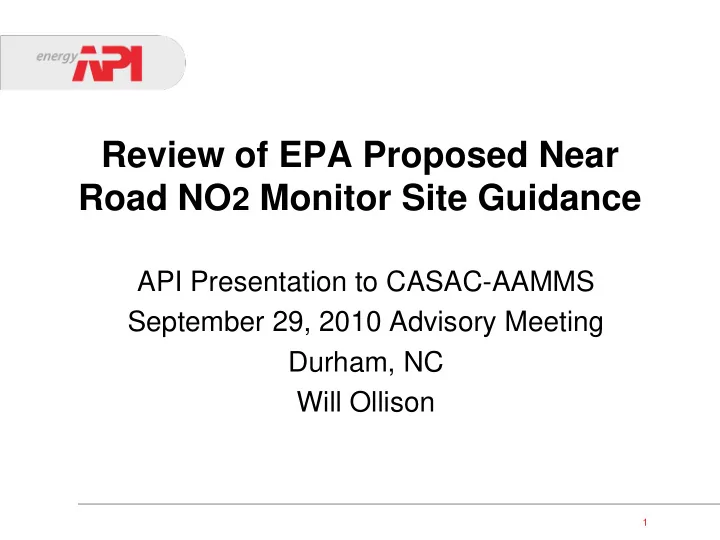

Review of EPA Proposed Near Road NO 2 Monitor Site Guidance API Presentation to CASAC-AAMMS September 29, 2010 Advisory Meeting Durham, NC Will Ollison 1
Summary Comment • Guidelines Must Explain How NO 2 Data will be used to Designate Near Road/MSA NAAQS Compliance and Initiate AQI Health Advisory System Notification • Guidelines Must Include Assessment of the Fleet Mix of High Emitting Vehicles that will Determine Near Road Peak NO 2 Levels • Guidelines Must Require Accurate Near Road Monitors to Mitigate Acknowledged NO 2 FRM Bias 1220 L Street, NW • Washington, DC 20005-4070 • www.api.org 2
How Will EPA Use Near Road Data? • Will Near Road NO 2 , CO, & PM Data be used to Designate Near Road and/or MSA NAAQS Non- Attainment? How will this be Addressed in the Near Road Siting Guidelines? Imposing added non-attainment facility controls without better ‘clunker’ enforcement is egregious implementation. • Will Near Road NO 2 , CO, & PM Data be used in the AQI Public Health Advisory System? How will this be Addressed in the Guidelines? 1220 L Street, NW • Washington, DC 20005-4070 • www.api.org 3
Impact of High Emitting Vehicles • Upper 10% of the Fleet Emits 60- 80% of the NOx • Diesel Particle Traps Increase NO 2 /NOx Emission Fraction from <10% to 30-60%. 1220 L Street, NW • Washington, DC 20005-4070 • www.api.org 4
March 8-14, 2008 Fresno, CA FEAT NO 2 Monitoring Site 1220 L Street, NW • Washington, DC 20005-4070 • www.api.org 5
March 8-14, 2008 Fresno, CA FEAT NO 2 Monitoring Site 1220 L Street, NW • Washington, DC 20005-4070 • www.api.org 6
Summary of Fresno NO 2 Results • 13,000 Vehicle Measurements • 91.4% of NO 2 from Dirtiest 10% of Fleet • Diesel Vehicles with Particle Traps Accounted for 0.4% of the Measurements but 14.8% of the Measured NO 2 Zhan, T., Stedman, D.H., Bishop, G.A., Peddle, A.M. (2009). On-road motor vehicle emissions including NH 3 , SO 2 , and NO 2 . Final California Air Resources Board Report, Contract No. 07-309 Bishop, G.A., Peddle, A.M., Stedman, D. H., Zhan, T. (2010). On-road emission measurements of reactive nitrogen compounds from three California cities. ES&T 44: 3616-342 0 1220 L Street, NW • Washington, DC 20005-4070 • www.api.org 7
Listed ASTM D3824 NO x FRM Interferences HNO 3 H 2 S HCl HONO COS Cl 2 N 2 O 5 CS 2 ClNO X NO 3 MeSH COCl 2 PAN EtSH CHCl 3 Methyl Nitrate Methyl Sulfide Cl 3 CCOCl Ethyl Nitrate Ethyl Sulfide Ethyl Nitrite Methylethyl Sulfide n ‐ Propyl Nitrate Methyl Disulfide n ‐ Butyl Nitrate Ethyl Disulfide Nitroethane Thiophenes Nitrocresol 2 ‐ methyl Alkanolamines 3 ‐ methyl Alkylamines 2,5 ‐ dimethyl 1220 L Street, NW • Washington, DC 20005-4070 • www.api.org 8
NO 2 Federal Reference Method Interference Bias To summarize this discussion of NO 2 measurement techniques and interferences: the current method of determining ambient NO X and then reporting NO 2 concentrations by subtraction of NO is subject to a consistently positive interference by NO X oxidation products, chiefly HNO 3 and peroxyacetyl nitrate (PAN) as well as other oxidized N-containing compounds, though the magnitude of this positive bias is largely unknown and can be rapidly changing. Measurements of these oxidation products in urban areas are sparse. Concentrations of these oxidation products are expected to peak in the afternoon because of the continued oxidation of NO 2 emitted during the morning rush hours and during conditions conducive to photochemistry in areas well downwind of sources, particularly during summer - EPA 2008 Nitrogen Oxides ISA at page 2-8. 1220 L Street, NW • Washington, DC 20005-4070 • www.api.org 9
NO 2 Federal Reference Method Interference Bias Within the urban core of metropolitan areas, where many of the ambient monitors are sited close to strong NO X sources such as motor vehicles on busy streets and highways (i.e., where NO 2 concentrations are highest), the positive artifacts due to the NO 2 oxidation products are much smaller on a relative basis, typically <~10%. Conversely, the positive artifacts are larger in locations more distant from NO X sources (i.e., where NO 2 concentrations are lowest) and could exceed 50%. Therefore, variable, positive artifacts associated with measuring NO 2 using the Federal Reference Method (FRM) severely hamper its ability to serve as an accurate and precise indicator of NO 2 concentrations at the typical ambient levels generally encountered outside of urban cores. - EPA 2008 Nitrogen Oxides ISA at page 2-8. 1220 L Street, NW • Washington, DC 20005-4070 • www.api.org 10
Less Biased NO 2 Monitors Must Be Required Near Roads • Photolytic Converter NO 2 FRMs – Teledyne-API & Air Quality Design (LEDs) – Eco Physics (Metal Halide Lamp) • Long/Open Path Visible/IR NO 2 Absorption – University of Denver (FEAT 3000 – 438 nm) – Aerodyne (Quantum Cascade – 1590 cm ־ ¹) 1220 L Street, NW • Washington, DC 20005-4070 • www.api.org 11
Recommend
More recommend